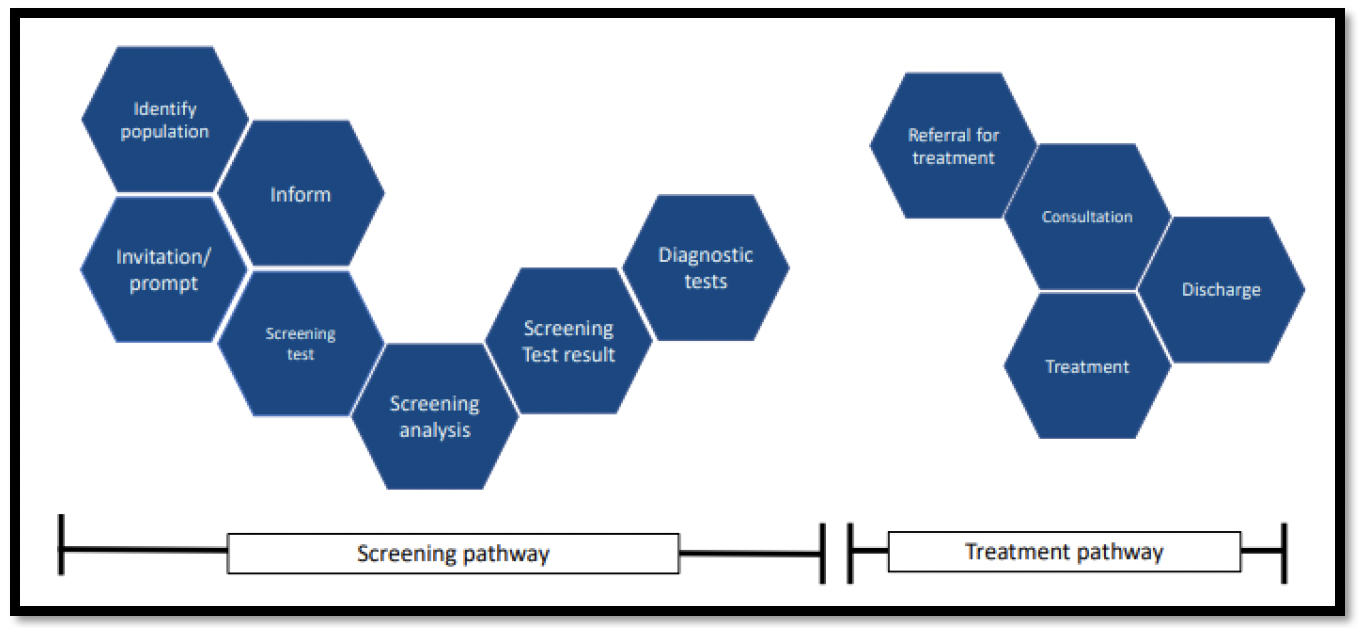Health screening: equity in screening strategy 2023 to 2026
The Scottish equity in screening strategy tackles inequalities within the screening programmes.
Context and background
National population screening programmes
Screening is a way of identifying people who appear healthy but who may have a higher chance of having a disease or condition[1]. Screening aims to detect early signs of a condition, enabling earlier treatment and improved health outcomes. Screening also provides better outcomes for the health service, by reducing demand on services associated with more serious or later-stage disease.
There are currently six national population screening programmes delivered in Scotland (see Table 1 below). These programmes have been introduced based on recommendations from the UK National Screening Committee. Each screening programme proactively invites people who, on the basis of age and sex, have a higher risk of the disease or condition.
Individuals can decide not to engage in a screening test, or to withdraw from interventions at later stages in the pathway after screening. This decision should be a personal informed choice. This means, a person should have access to accurate, evidence-based information in a format which meets their needs.
| National Screening Programme | Eligible Population | Screening Interval |
|---|---|---|
| Scottish Abdominal Aortic Aneurysm (AAA) Screening Programme | All men and people assigned male at birth aged 65 | One-off screen |
| Scottish Bowel Screening Programme | People aged 50 to 74 People aged 75 and over can request a screening test but will not be routinely invited | Every 2 years |
| Scottish Breast Screening Programme | Women and people assigned female at birth aged 50 to 70 Those aged 71 to 75 can self-refer for breast screening. To note, due to the effect of COVID-19 on screening capacity, self-referrals are temporarily restricted to those aged 71-75 years and those aged 71 and over with a history of breast cancer. | Every 3 years |
| Scottish Cervical Screening Programme | Women and people with a cervix, aged 25 to 64 | Every 3-5 years depending on findings |
| Scottish Diabetic Eye (DES) Screening Programme | People aged 12 and over with type 1 or type 2 diabetes | Every 1-2 years depending on findings |
| Scottish Pregnancy and Newborn Screening Programme | Pregnant women and people who are pregnant. Various tests from before 10 weeks, through to between 18 to 21 weeks. Newborn babies. Various tests within the first days and weeks. | Various one-off screens including some with a two stage process |
Screening includes both a 'screening pathway' and a 'treatment pathway' (Figure 1). Screening programmes invite people from an eligible population for a screening test. Depending on the outcome of that test, some people will then be invited for a diagnostic test as the final step in the screening pathway. Following a positive diagnosis, an individual is then referred into the treatment pathway. Individuals must complete their journey through the screening and treatment pathways to improve health outcomes.
It is important to understand that inequalities can occur at any point along the screening or treatment pathways.

Source: National Services Scotland (2022), A guide to National Population Screening in Scotland.
How the strategy has been developed
A great deal of national and local NHS work has been undertaken to address inequalities in screening in the past. Often though, this has lacked dedicated and sustained system-wide leadership, and that lack of leadership has affected the momentum for tackling inequalities at scale across screening programmes.
In 2022, National Screening Oversight (NSO) – which was established in early 2020 to provide oversight, assurance, and direction to Scotland's national screening programmes – identified an opportunity to provide greater direction and leadership to reducing inequalities in screening.
NSO engaged key stakeholder and partner organisations in a reference group to discuss how best to drive improvement in inequalities, and the production of this strategy and separate action plan (appendix 1). Representation included Scottish Government, NHS Boards, third sector organisations and academic institutions (appendix 2).
The reference group met five times between July 2022 and April 2023 and identified five priority areas for improvement and action:
- Communications, engagement, and learning
- Access to screening
- Data collection and monitoring
- Research and evaluation
- 'Overarching issues'
The theme of 'overarching issues' was discussed by the reference group. The remaining four priority areas were explored in more detail by four corresponding sub-groups. Sub-groups met on several occasions between October and December 2022 to agree a range of actions needed to address the main challenges to uptake and engagement across the screening pathway.
For all five sub-themes, long-term outcomes have been agreed (as set out above), detailing what we will need to deliver if we are to achieve our vision.
Data and evidence have played a central role to the development of this strategy. Public Health Scotland has provided valuable insight into the published data. Systematic reviews have provided the published evidence, together with some Scottish research studies.
NSO carried out an equality and fairer Scotland impact assessment (EFSIA) with partner organisations to help us consider the likely effects of the strategy on different groups eligible for screening. A copy of the EFSIA is available on request.
In collaboration with the reference group and sub-groups, NSO has written this strategy and separate action plan. The National Screening Oversight Board (NSOB) will be responsible for overseeing the implementation and delivery of these.
Contact
Email: screening@gov.scot
There is a problem
Thanks for your feedback